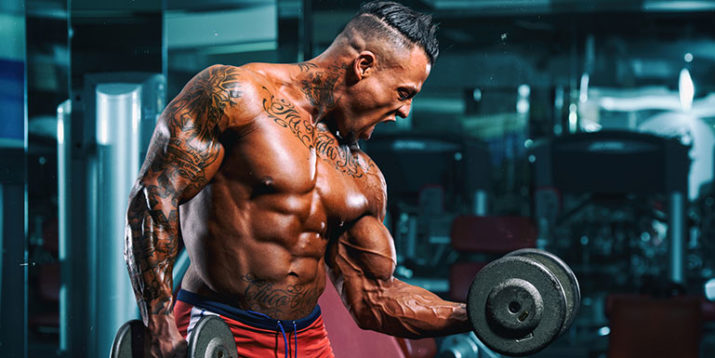4 Bro Science Fitness Myths You Can Ignore

Tune into gym locker room conversations and you’ll hear all kinds of amazing fitness insights flying around. On the surface, these anecdotal words of wisdom can seem plausible, particularly when they’re coming straight from the mouth of someone who looks like they’re in killer shape.
But the reality is that a lot of commonly held beliefs about exercise just aren’t backed by fact. So what do you believe? Join us as we debunk four of the most popular bro science myths.
Feel Free to Flout These Baseless Bro Science Myths
Bro Science Myth 1: Eating at Night Makes You Fat
The problem isn’t when you eat, it’s what you eat. At night, when we’re tired, it’s all too tempting to reach for sugar-laden, calorific snacks that are tasty and convenient. It can be this that leads to weight gain rather than the time at which we eat.
But what about the bro science theory that says because we’re inactive when we sleep, we don’t burn the calories we consume just before hitting the sack? “That theory was popular in the ’90s,” says Doug Joachim, a personal trainer based in New York. “But since then, the research has shown otherwise.”
Related: Is Eating Before Bed a Bad Idea?
In fact, targeted midnight munchies may actually help you recover from exercise. A study in the journal Medicine & Science in Sports & Exercise had recreationally active males perform resistance exercises at 8 p.m., and then gave them 40g of casein protein 30 minutes before they went to sleep.
Those who consumed the casein had higher plasma essential amino acid concentrations, indicating that the protein was effectively digested and absorbed before sleep. This led to higher whole-body and muscle protein synthesis rates and a net positive protein balance during the night compared to those who didn’t take the casein protein.
So put your slippers on and raid the fridge — as long as it’s for something healthy.
Bro Science Myth 2: Crunches Reduce Belly Fat
If you want a six-pack, you need to do lots and lots of crunches, right? Wrong, bro. Crunches are one of the most overrated exercises you can do.
“Crunches don’t work the transverse abdominis (TVA),” says Joachim. “It pulls in your viscera and protects your spine. By strengthening it with core stabilization exercises like the plank or anti-rotation exercises, you’ll make it pull in your viscera, which gives you a flatter stomach.”
Related: Can You Crunch Your Way to a Flat Stomach?
What’s more, a small, randomized controlled trial in Illinois in 2011 proved that sit-ups did nothing to reduce waist size. During the test, one group was asked to perform daily abdominal exercises while the control group did none. Detailed measurements were taken after a six-week period and it was found that the sit-ups had no impact on waist size or the amount of fat the subjects had around their stomachs.
Still not sold? What if we told you all those crunch sets could actually damage your body? “Crunches involve a lot of inter-abdominal pressure, which can cause the rectus abdominis muscles to separate,” says Jason Keigher, a personal trainer based in Texas. “It’s a big problem for women who have just given birth. Not only can it hurt your lower back, it can also give you a bulge that looks like a potbelly. So crunches are really counterproductive.”
Bro Science Myth 3: Lots of Cardio Is the Only Way to Drop Weight
While it’s true that you don’t see many fat long-distance runners, cardio isn’t the best means to shed pounds. If you want to get trim, you’re technically better off lifting weights.
“Strength training increases your (metabolic) burn rate,” says Keigher, up to 72 hours after a workout. Not to mention that muscle at rest inherently burns more calories than fat. “So the more muscle you have, the more efficient your body is at burning calories.” In other words, by focusing on building muscle, you’ll get more from your fitness efforts.
Cardio has another consequence — runner’s hunger. “When you do lots of cardio, it potentiates the ghrelin hormone” that signals hunger to the brain, according to Joachim, who says weight training and other anaerobic activities don’t effect this in the same measure. “That’s why people are often famished after a run, but less so after lifting weights.”
Of course cardio is still essential to a balanced fitness regimen. But to maximize results, you should work out with resistance bands, dumbbells, and/or weights, as prescribed in Beachbody programs like The Master’s Hammer and Chisel and P90X. Not only will you drop a couple of dress sizes or belt notches, you’ll gain more definition. These exercises are also easier on your joints. And unlike running, they don’t involve stepping out in the rain.
Bro Science Myth 4: Lifting Weights Will Make You Bulky
A lot of women want to get in shape, but hate the idea of bulking up — hence they never lift weights. According to Joachim, their worries are misplaced.
“If you’re a woman, lifting weights isn’t going to bulk you up,” he says. In addition to the necessary genetics, “to bulk up you need a boatload of testosterone, and typically women don’t have enough for it to be a problem.”
Related: 10 Reasons Women Should Lift Weights

But what about female bodybuilders? They didn’t get that ripped playing Tic-Tac-Toe. “Certain women do have more testosterone and hence the propensity to bulk up,” says Joachim, not to mention that bodybuilders lift with the specific intent of gaining mass. “But the vast majority of women will gain lean muscle mass when they lift weights, making them look trimmer and more athletic.”
If you’re still turned off by weights, remember this: Those bodybuilders are training for hours every day and taking all sorts of supplements to look ripped. Building some weight and resistance training into your routine will only enhance your figure.